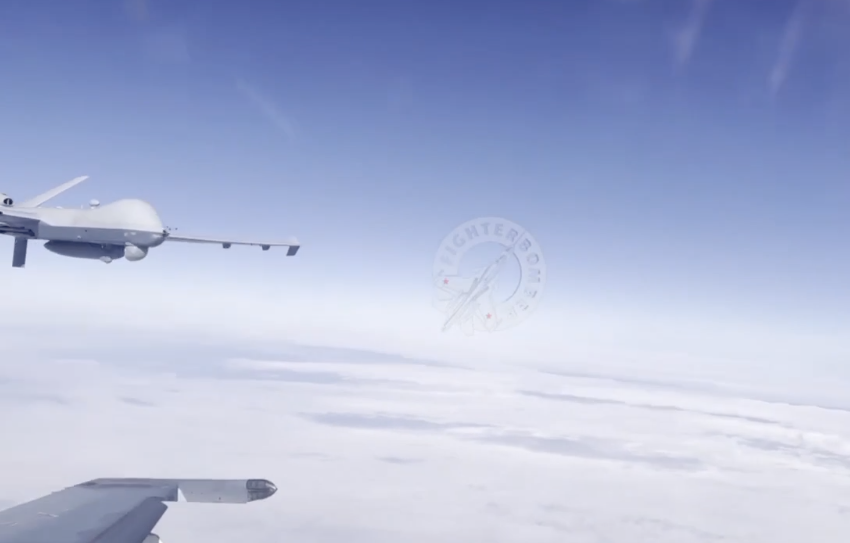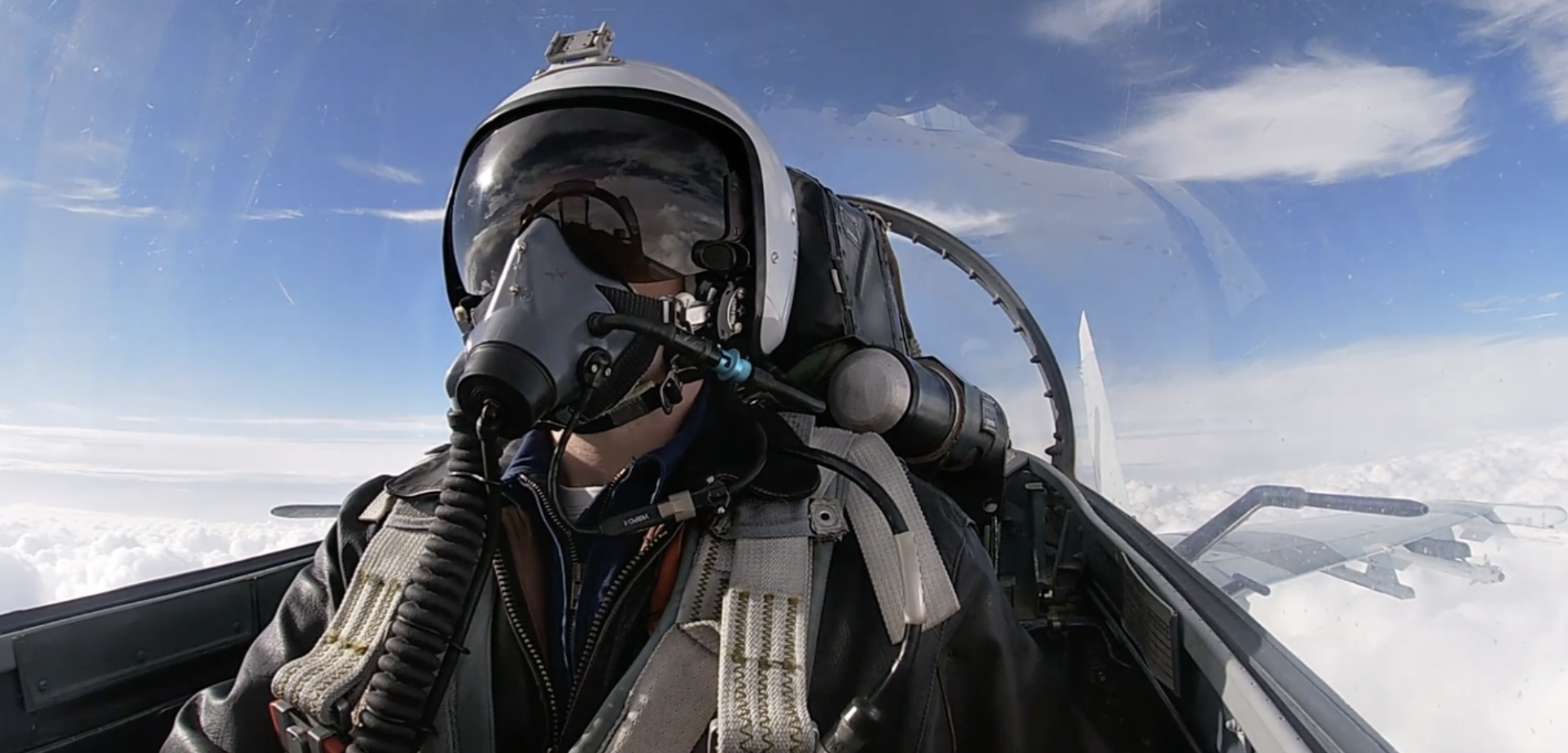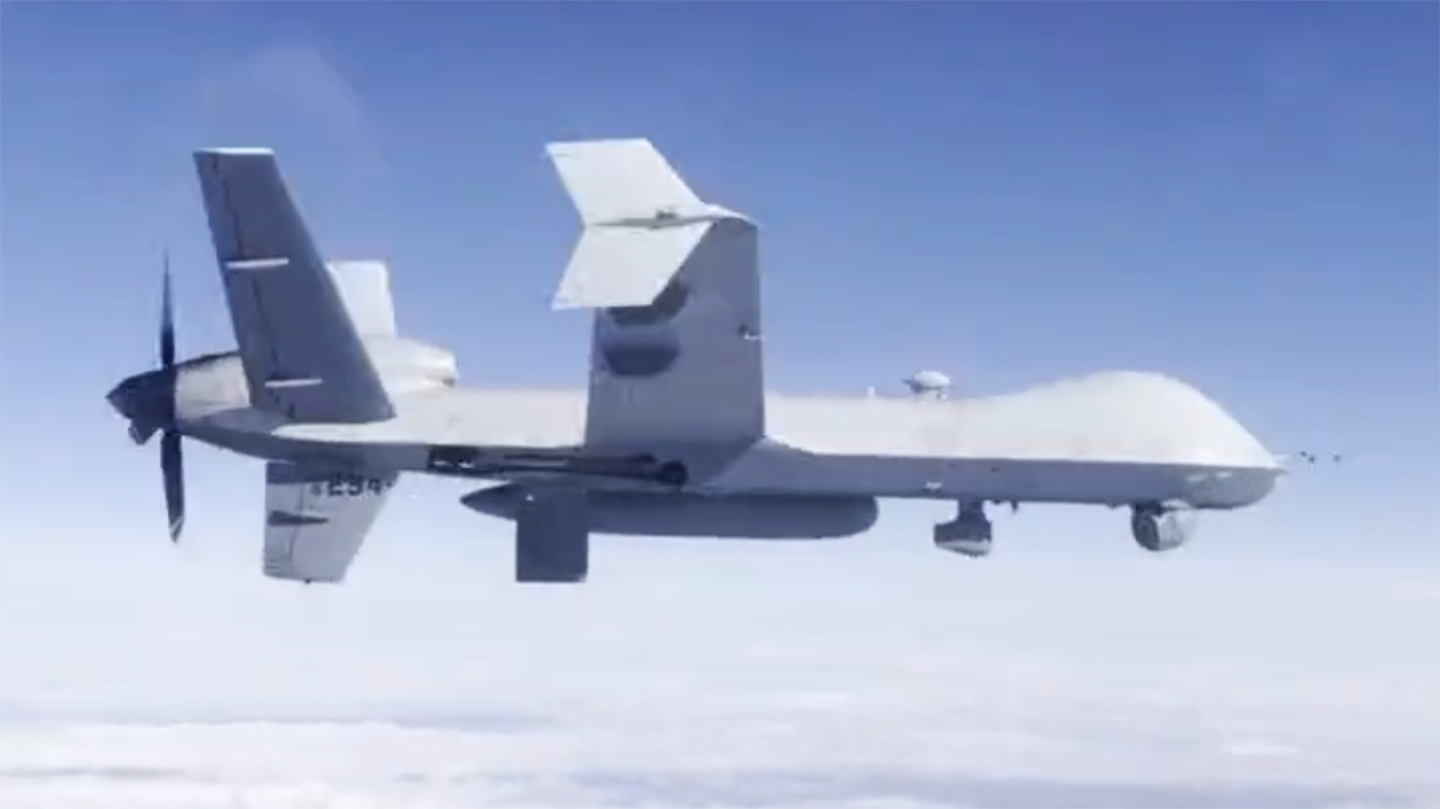A video has surfaced that allegedly shows a close pass involving a U.S. Air Force MQ-9 Reaper and a Russian Su-27 Flanker fighter jet, the two types that were involved in a collision over the Black Sea yesterday. Readers of The War Zone can get fully up to speed on what is known about this incident in our initial reporting here. Since then, U.S. Defense Secretary Lloyd Austin has added his comments on the incident, describing it as a “hazardous episode [that] is part of a pattern of aggressive, risky, and unsafe actions by Russian pilots in international airspace.”
The video, just four seconds long, was apparently first posted to the Telegram Messenger service by the popular pro-Russian Fighterbomber account earlier today. Seemingly taken from the cockpit of a Flanker-series fighter — likely a first-generation Su-27, although that can’t be confirmed — the video shows a close flyby of a U.S. Air Force MQ-9 off the port side of the jet.

The Reaper itself is a later-model MQ-9A with a four-bladed propeller, winglets, a range-extending underwing fuel tank, and a large vertical blade antenna that we have seen before but the purpose of which remains unclear. We have also seen this general arrangement on MQ-9As operating out of Romania in the past, though we still don’t know where the drone involved in the incident was flying from.
Earlier video showing U.S. Air Force MQ-9 operations in Romania:

The close flyby would be broadly in accordance with statements from U.S. officials yesterday, confirming that the Su-27 involved in the collision passed the drone several times. However, the video may have been taken from the second Su-27 involved, or it could date from a totally different occasion, providing it actually is genuine footage.
The dramatic speed differential between Su-27 and MQ-9 is also apparent in the video. This is one factor that has been raised as a possible reason for the collision, with the Su-27 pilot perhaps having unintentionally rammed the drone when the latter adjusted its speed or flight profile. Sources familiar with MQ-9 operations have told The War Zone that even small power changes can result in relatively rapid deceleration for the MQ-9.

On the other hand, the video does not show any of the more aggressive maneuvers said to have been performed by the Russian fighter. These included dumping fuel on and flying directly in front of the MQ-9 before the Su-27 reportedly struck the drone’s propeller.
With that in mind, we can’t say for certain whether the video dates from yesterday’s incident. After all, MQ-9s are a frequent presence over the Black Sea and it should be no surprise that they would have been intercepted by Russian fighters on multiple occasions previously.
There is also the possibility that the video has been produced using computer-generated imagery (CGI), perhaps using some form of flight simulation software. However, the reflections of the pilot’s helmet, a gloved hand, and possibly also a smartphone on the inside of the cockpit canopy would suggest it may well be genuine. There’s also a suggestion of some kind of dirty mark on the cockpit canopy, again not necessarily consistent with a CGI production. Overall, we assess the video to not be from Digital Combat Simulator and most likely genuine.
We have reached out to U.S. Europe Command (EUCOM) and U.S. Air Forces In Europe (USAFE) to try and ascertain whether the footage is genuine and to get their take on it.
Meanwhile, we might not have to wait too long for an officially released video of the incident, with Pentagon spokesman Pat Ryder having said that the U.S. Department of Defense is currently in the process of declassifying its own footage, recorded from the MQ-9.
Further information has emerged since our initial reporting of the incident, too. In response to a query from The War Zone, USAFE has confirmed that no NATO aircraft were scrambled as a result of the collision. Meanwhile, U.S. Defense Secretary Austin confirmed that the United States will continue to fly and operate “wherever international law allows.” He added: “It is incumbent upon Russia to operate its military aircraft in a safe and professional manner.”
Meanwhile, an unnamed U.S. military official has provided a more detailed description of the incident, based on a video from the MQ-9 they have seen. The anonymous official told Nick Schifrin of PBS that the contact between jet and drone “was not a controlled tap,” and that the Russian pilot was “barreling toward the drone” and “out of control,” when they hit the propeller. “Not something you’d see a professional pilot do. It was amateur hour,” the official added.
Meanwhile, Russia’s state-run TASS news agency deflects from the collision itself by claiming that “U.S. drones are collecting reconnaissance data to be used by the Kyiv forces for their future strikes on the Russian territory and troops.” The agency also quotes the Russian Ambassador to the United States Anatoly Antonov, who said: “The unacceptable actions of the United States military in the close proximity to our borders are cause for concern. We are well aware of the missions such reconnaissance and strike drones are used for.”
“We perceive any actions involving the use of American weapons and military equipment as openly hostile,” Antonov added.
Also on the Russian side, there are reports, the origins of which are currently unclear, that the director of the Foreign Intelligence Service, or SVR, Sergey Naryshkin has claimed that Russia has undisclosed “technical capabilities” that could be used to recover the wreckage of the drone. This comes as the White House’s John Kirby confirms that the wreckage has not been recovered from the Black Sea, although the White House also says that the United States has taken measures — the nature of which remains unclear — to prevent the downed MQ-9 from falling into the wrong hands.
While we can’t say with absolute certainty yet if this brief video is the real deal and whether it does indeed date from yesterday’s incident, there’s every indication that footage yet to be released will provide a better understanding of exactly what happened. Depending on the kind of imagery that the U.S. side is able to provide, we may well get to appreciate exactly how “reckless” and “unprofessional” the intercept was — to use the Pentagon’s own descriptions.
Further video might even shed some light on the motives of the Russian pilot. As it now stands, U.S. officials have not declared one way or another if there was a deliberate intention to bring down the drone. “There was [a] deliberate intent to interfere with the MQ-9, but the collision seems to be simple incompetence,” an Air Force official previously told The War Zone.
Once more evidence emerges, it may be possible to get a better understanding of whether the Russian pilot was actually trying to bring down the drone or if it was more a case of them misjudging a maneuver.
In the meantime, the Russian Ministry of Defense has stated that there was not a collision and that the MQ-9 maneuvered sharply before apparently entering uncontrolled flight and falling into the Black Sea. Again, the availability of more substantial footage should help determine the truth of that claim.
Update 3/15 8:20 p.m. EST:
Gen. Sergei Shoigu, Russian Minister Of Defense, and U.S. Secretary of Defense Lloyd Austin held a phone conversation on Wednesday, March 15 to discuss the incident with the MQ-9.
The Pentagon has since published a readout summarizing the main points discussed that can be attributed to Press Secretary Air Force Brig. Gen. Pat Ryder:
- “On March 15, Secretary of Defense Lloyd J. Austin III spoke by phone with Russian Minister of Defense Sergey Shoygu regarding recent unprofessional, dangerous, and reckless behavior by the Russian air force in international airspace over the Black Sea. Secretary Austin emphasized that the United States will continue to fly and to operate wherever international law allows.”
In a separate statement, the Russian Ministry of Defense has detailed its own takeaways from the call:
- “Sergei Shoigu pointed out that the incident was caused by the U.S. actions of non-compliance with the flight restriction zone declared by the Russian Federation, established in connection with the special military operation, as well as increased reconnaissance activities against the interests of the Russian Federation.”
- “It is noted that the U.S. flights of strategic unmanned aerial vehicles off the coast of Crimea are provocative in nature, which creates preconditions for the escalation of the situation in the Black Sea area.”
- “The Russian Federation is not interested in such development, but it will continue to respond to all provocations in a proportionate manner. At the same time, the major nuclear powers should act as responsibly as possible, including maintaining military channels of communication to discuss any crisis situations.”
In today’s Pentagon press briefing, Gen. Milley also noted that the U.S. is aware of the location where the MQ-9 went down in the Black Sea.
“It’s probably about maybe 4,000 or 5,000 feet of water, something like that. So, any recovery operation is very difficult at that depth by anyone. That’s the first point,” Milley said. “Secondly, we don’t have any ships there, but we do have a lot of allies and friends in the area. We’ll work through recovery operations. That’s U.S. property and we’ll leave it that at this point, but it probably broke up. There’s probably not a lot to recover, frankly.”
“As far as the loss of anything of sensitive intelligence, et cetera, as normal, we would take — and we did take mitigating measures, so we are quite confident that whatever was of value is no longer of value,” Milley added.
What those measures are is unclear.
According to CNN, which cites two unnamed U.S. officials, Russian forces have now reached the MQ-9’s crash site. White House National Security Council spokesperson John Kirby did not confirm to CNN whether or not Russians were at the site, but Russia’s Navy does have several ships in the Black Sea and the Kremlin has said it will attempt to recover the drone.
UPDATE: 9:25AM EST—
We now have footage released from the DoD showing the collision with the SU-27 from the MQ-9’s MTS sensor turret. See our fully story and the video here.
Contact the author: thomas@thedrive.com
